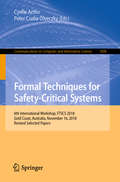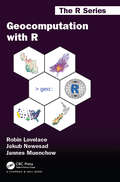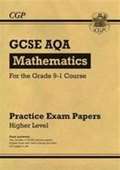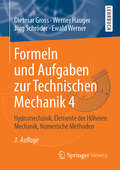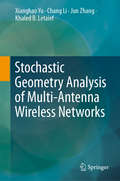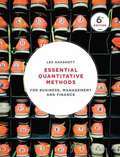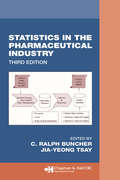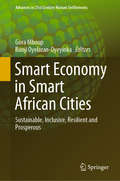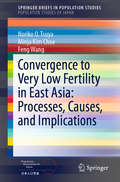- Table View
- List View
Impulsive Systems on Hybrid Time Domains (IFSR International Series in Systems Science and Systems Engineering #33)
by Xinzhi Liu Kexue ZhangThis monograph discusses the issues of stability and the control of impulsive systems on hybrid time domains, with systems presented on discrete-time domains, continuous-time domains, and hybrid-time domains (time scales). Research on impulsive systems has recently attracted increased interest around the globe, and significant progress has been made in the theory and application of these systems. This book introduces recent developments in impulsive systems and fundamentals of various types of differential and difference equations. It also covers studies in stability related to time delays and other various control applications on the different impulsive systems. In addition to the analyses presented on dynamical systems that are with or without delays or impulses, this book concludes with possible future directions pertaining to this research.
Formal Techniques for Safety-Critical Systems: 6th International Workshop, FTSCS 2018, Gold Coast, Australia, November 16, 2018, Revised Selected Papers (Communications in Computer and Information Science #1008)
by Cyrille Artho Peter Csaba ÖlveczkyThis book constitutes the refereed proceedings of the 6th International Workshop on Formal Techniques for Safety-Critical Systems, FTSCS 2018, held in Gold Coast, Australia in November 2018.The 10 revised full papers presented together with an abstract of an invited talk were carefully reviewed and selected from 22 submissions. The papers are organized in topical sections on analysis and verification of Safety-Critical Systems; analysis of timed systems; semantics and analysis methods, and model transformation.
Moritz Schlick. Vorlesungen und Aufzeichnungen zur Logik und Philosophie der Mathematik (Moritz Schlick. Gesamtausgabe)
by Martin Lemke Anne-Sophie NaujoksIn diesem Band sind die nachgelassenen Schriften Moritz Schlicks zur Logik und Philosophie der Mathematik gesammelt, ediert und kommentiert. Keine der zu Lebzeiten veröffentlichten Schriften Schlicks war ausschließlich diesen Themen gewidmet. Man sollte daraus jedoch nicht den Schluss zu ziehen, diese Themen hatten an der Peripherie von Schlicks Interesse gelegen. Überlegungen zur Logik und Mathematik ziehen sich durch Schlicks gesamtes Werk, von der Habilitation, über sein Opus Magnum, die Allgemeine Erkenntnislehre, bis zu seinen letzten stark von Ludwig Wittgenstein geprägten Aufsätzen in den 1930er Jahren. Es ist vielmehr so, dass Schlick Fragen der Logik und Mathematikphilosophie stets im Zusammenhang mit anderen Problemen sah und sie deshalb nie einzeln für sich behandelte. Ausnahmen machte er vor allem für Lehrveranstaltungen und so wundert es nicht, dass fast alle Texte dieses Bandes im Umkreis von solchen entstanden sind.
Fuel Tank Sloshing Simulation Using the Finite Volume Method (BestMasters)
by Matthäus JägerMatthäus Jäger examines the simulation of liquid-gas flow in fuel tank systems and its application to sloshing problems. The author focuses at first on the physical model and the assumptions necessary to derive the respective partial differential equations. The second step involves the cell-centered finite volume method and its application to fluid dynamic problems with free surfaces using a volume of fluid approach. Finally, the application of the method for different use cases is presented followed by an introduction to the methodology for the interpretation of the results achieved.
Geocomputation with R (Chapman & Hall/CRC The R Series)
by Robin Lovelace Jakub Nowosad Jannes MuenchowGeocomputation with R is for people who want to analyze, visualize and model geographic data with open source software. It is based on R, a statistical programming language that has powerful data processing, visualization, and geospatial capabilities. The book equips you with the knowledge and skills to tackle a wide range of issues manifested in geographic data, including those with scientific, societal, and environmental implications. This book will interest people from many backgrounds, especially Geographic Information Systems (GIS) users interested in applying their domain-specific knowledge in a powerful open source language for data science, and R users interested in extending their skills to handle spatial data. The book is divided into three parts: (I) Foundations, aimed at getting you up-to-speed with geographic data in R, (II) extensions, which covers advanced techniques, and (III) applications to real-world problems. The chapters cover progressively more advanced topics, with early chapters providing strong foundations on which the later chapters build. Part I describes the nature of spatial datasets in R and methods for manipulating them. It also covers geographic data import/export and transforming coordinate reference systems. Part II represents methods that build on these foundations. It covers advanced map making (including web mapping), "bridges" to GIS, sharing reproducible code, and how to do cross-validation in the presence of spatial autocorrelation. Part III applies the knowledge gained to tackle real-world problems, including representing and modeling transport systems, finding optimal locations for stores or services, and ecological modeling. Exercises at the end of each chapter give you the skills needed to tackle a range of geospatial problems. Solutions for each chapter and supplementary materials providing extended examples are available at https://geocompr.github.io/geocompkg/articles/.
New GCSE Maths AQA Practice Papers: Higher - for the Grade 9-1 Course (PDF)
by Cgp BooksThis pack from CGP contains two sets of complete practice exams, with detailed answers and mark schemes. They match the content and style of the AQA Grade 9-1 Higher Level Maths GCSE exams, with a separate booklet for each paper - just like the real thing. The mark scheme is straightforward to use, including hints and tips, making this the perfect way to prepare for the exams.
Formeln und Aufgaben zur Technischen Mechanik 4: Hydromechanik, Elemente der Höheren Mechanik, Numerische Methoden
by Dietmar Gross Werner Hauger Jörg Schröder Ewald WernerMit diesem Buch üben Sie wichtige Formeln und Aufgaben der technischen Mechanik Dieses Buch enthält die wichtigsten Formeln und zahlreiche Aufgaben und Lösungsbeispiele zu ausgewählten Teilgebieten der technischen Mechanik. Im Mittelpunkt dieses Werks stehen:• Hydromechanik• numerische Methoden• Elemente der höheren MechanikMit seinem ausgeprägten Fokus auf Aufgaben und Formeln wird dieses Werk zur idealen Ergänzung zum Lehrbuch „Technische Mechanik 4“ und eignet sich gleichzeitig als Nachschlagewerk zur vertiefenden Auseinandersetzung mit der technischen Mechanik. Die von den Autoren zusammengestellten Aufgaben überzeugen durch Klarheit und Verständlichkeit und ermöglichen es Ihnen, den jeweiligen Lösungsweg eigenständig zu finden.Sieben verschiedene Fachgebiete stehen im FokusDas Buch und die enthaltenen Formeln und Aufgaben widmen sich den folgenden sieben Stoffgebieten der technischen Mechanik:1. Hydromechanik2. Grundlagen der Elastizitätstheorie3. Statik spezieller Tragwerke4. Schwingungen kontinuierlicher Systeme5. Stabilität elastischer Strukturen6. Viskoelastizität und Plastizität 7. Numerische Methoden der MechanikÜberarbeitete Auflage – ideal für IngenieurstudentenDie einzelnen Kapitel des Buchs sind durchgängig gleich aufgebaut. Zunächst geben Ihnen die Autoren einen Überblick über die wichtigsten Formeln des jeweiligen Teilgebiets. Das Verhältnis der einzelnen Bezugsgrößen zueinander wird mit Hilfe von zahlreichen detaillierten Abbildungen und Tabellen erläutert. Dadurch sind Sie in der Lage, selbstständig Grundgleichungen zu erstellen. Nach der Theorie folgt in jedem Kapitel schließlich der Aufgabenteil inklusive ausführlicher Lösungen. So können Sie bereits Gelerntes auffrischen und schnelle Lernerfolge erzielen. Nach dem großen Erfolg der 2. Auflage handelt es sich bei dem vorliegenden Buch um eine redaktionell überarbeitete und umfassend ergänzte Neuauflage. Mit den zahlreichen Formeln und Aufgaben zur technischen Mechanik eignet es sich insbesondere für Ingenieurstudenten aller Fachrichtungen an Universitäten oder Fachhochschulen.
Stochastic Geometry Analysis of Multi-Antenna Wireless Networks
by Xianghao Yu Chang Li Jun Zhang Khaled B. LetaiefThis book presents a unified framework for the tractable analysis of large-scale, multi-antenna wireless networks using stochastic geometry. This mathematical analysis is essential for assessing and understanding the performance of complicated multi-antenna networks, which are one of the foundations of 5G and beyond networks to meet the ever-increasing demands for network capacity. Describing the salient properties of the framework, which makes the analysis of multi-antenna networks comparable to that of their single-antenna counterparts, the book discusses effective design approaches that do not require complex system-level simulations. It also includes various application examples with different multi-antenna network models to illustrate the framework’s effectiveness.
Proceedings of the Third International Conference on Computing, Mathematics and Statistics (iCMS2017): Transcending Boundaries, Embracing Multidisciplinary Diversities
by Liew-Kee Kor Abd-Razak Ahmad Zanariah Idrus Kamarul Ariffin MansorThis book is a product of the Third International Conference on Computing, Mathematics and Statistics (iCMS2017) to be held in Langkawi in November 2017. It is divided into four sections according to the thrust areas: Computer Science, Mathematics, Statistics, and Multidisciplinary Applications. All sections sought to confront current issues that society faces today. The book brings collectively quantitative, as well as qualitative, research methods that are also suitable for future research undertakings. Researchers in Computer Science, Mathematics and Statistics can use this book as a sourcebook to enrich their research works.
Quantum Physics and Geometry (Lecture Notes of the Unione Matematica Italiana #25)
by Edoardo Ballico Alessandra Bernardi Iacopo Carusotto Sonia Mazzucchi Valter MorettiThis book collects independent contributions on current developments in quantum information theory, a very interdisciplinary field at the intersection of physics, computer science and mathematics. Making intense use of the most advanced concepts from each discipline, the authors give in each contribution pedagogical introductions to the main concepts underlying their present research and present a personal perspective on some of the most exciting open problems. Keeping this diverse audience in mind, special efforts have been made to ensure that the basic concepts underlying quantum information are covered in an understandable way for mathematical readers, who can find there new open challenges for their research. At the same time, the volume can also be of use to physicists wishing to learn advanced mathematical tools, especially of differential and algebraic geometric nature.
Teaching Mathematics in the Secondary School (Developing as a Reflective Secondary Teacher)
by Mr Paul Chambers Robert TimlinThis fully updated third edition looks at the fundamentals of mathematics teaching, how to plan lessons and assess learning, and how to promote an inclusive approach in the classroom. Key new features include: Updated content reflecting: the 2014 National Curriculum in England, the Teachers' Standards and revised requirements for GCSE and A level mathematics Updated 'Evidence from research' features, highlighting developments in the field An expanded section on mathematical misconceptions New coverage on teaching for mastery.
Statistics In the Pharmaceutical Industry (Chapman & Hall/CRC Biostatistics Series)
by C. Ralph Buncher Jia-Yeong TsayThe growth of the pharmaceutical industry over the past decade is astounding, but the impact of this growth on statistics is somewhat confusing. While software has made analysis easier and more efficient, regulatory bodies now demand deeper and more complex analyses, and pharmacogenetic/genomic studies serve up an entirely new set of challenges. For more than two decades, Statistics in the Pharmaceutical Industry has been the definitive guide to sorting through the challenges in the industry, and this Third Edition continues that tradition. Updated and expanded to reflect the most recent trends and developments in the field, Statistics in the Pharmaceutical Industry, Third Edition presents chapters written by experts from both regulatory agencies and pharmaceutical companies who discuss everything from experimental design to post-marketing studies. This approach sheds light on what regulators consider acceptable methodologies and what methods have proven successful for industrial statisticians. Both new and revised chapters reflect the increasingly global nature of the industry as represented by authors from Japan and Europe, the increasing trend toward non-inferiority/equivalence testing, adaptive design in clinical trials, global harmonization of regulatory standards, and multiple comparison studies. The book also examines the latest considerations in anti-cancer studies. Statistics in the Pharmaceutical Industry, Third Edition demystifies the approval process by combining regulatory and industrial points of view, making it a must-read for anyone performing statistical analysis at any point in the drug approval process.
Smart Economy in Smart African Cities: Sustainable, Inclusive, Resilient and Prosperous (Advances in 21st Century Human Settlements)
by Gora Mboup Banji Oyelaran-OyeyinkaThis book highlights the use of information and communication technology (ICT) infrastructures in order to develop smart cities and produce smart economies in Africa. It discusses a robust set of concepts, including smart planning, smart infrastructure development, smart economic development, smart environmental sustainability, smart social development, resilience, and smart peace and security in several African cities. By drawing on the accumulated knowledge on various conditions that make cities smart, green, livable and healthy, it helps in the planning, design and management of African urbanization. In turn, it fosters the development of e-commerce, e-education, e-governance, etc. The rapid development of ICT infrastructures facilitates the creation of smart economies in digitally served cities and towns through smart urban planning, smart infrastructures, smart land tenure and smart urban policies. In the long term, this can reduce emissions of CO2, promote the creation of low carbon cities, reduce land degradation and promote biodiversity.
Electric Potential in Toroidal Plasmas (Springer Series in Plasma Science and Technology)
by A.V. MelnikovThis work introduces heavy ion beam probe diagnostics and presents an overview of its applications. The heavy ion beam probe is a unique tool for the measurement of potential in the plasma core in order to understand the role of the electric field in plasma confinement, including the mechanism of transition from low to high confinement regimes (L–H transition). This allows measurement of the steady-state profile of the plasma potential, and its use has been extended to include the measurement of quasi-monochromatic and broadband oscillating components, the turbulent-particle flux and oscillations of the electron density and poloidal magnetic field.Special emphasis is placed on the study of Geodesic Acoustic Modes and Alfvén Eigenmodes excited by energetic particles with experimental data sets. These experimental studies help to understand the link between broadband turbulent physics and quasi-coherent oscillations in devices with a rather different magnetic configuration.The book also compares spontaneous and biased transitions from low to high confinement regimes on both classes of closed magnetic traps (tokamak and stellarator) and highlights the common features in the behavior of electric potential and turbulence of magnetized plasmas.A valuable resource for physicists, postgraduates and students specializing in plasma physics and controlled fusion.
What is Fundamental? (The Frontiers Collection)
by Anthony Aguirre Brendan Foster Zeeya MeraliAre there truly fundamental entities in nature? Or are the things that we regard as fundamental in our theories – for example space, time or the masses of elementary particles – merely awaiting a derivation from a new, yet to be discovered theory based on elements that are more fundamental? This was the central question posed in the 2018 FQXi essay competition, which drew more than 200 entries from professional physicists, philosophers, and other scholars. This volume presents enhanced versions of the fifteen award-winning essays, giving a spectrum of views and insights on this fascinating topic. From a prescription for “when to stop digging” to the case for strong emergence, the reader will find here a plethora of stimulating and challenging ideas - presented in a largely non-technical manner - on which to sharpen their understanding of the language of physics and even the nature of reality.
Schrödinger Equations in Nonlinear Systems
by Wu-Ming Liu Emmanuel KengneThis book explores the diverse types of Schrödinger equations that appear in nonlinear systems in general, with a specific focus on nonlinear transmission networks and Bose–Einstein Condensates. In the context of nonlinear transmission networks, it employs various methods to rigorously model the phenomena of modulated matter-wave propagation in the network, leading to nonlinear Schrödinger (NLS) equations. Modeling these phenomena is largely based on the reductive perturbation method, and the derived NLS equations are then used to methodically investigate the dynamics of matter-wave solitons in the network. In the context of Bose–Einstein condensates (BECs), the book analyzes the dynamical properties of NLS equations with the external potential of different types, which govern the dynamics of modulated matter-waves in BECs with either two-body interactions or both two- and three-body interatomic interactions. It also discusses the method of investigating both the well-posedness and the ill-posedness of the boundary problem for linear and nonlinear Schrödinger equations and presents new results. Using simple examples, it then illustrates the results on the boundary problems. For both nonlinear transmission networks and Bose–Einstein condensates, the results obtained are supplemented by numerical calculations and presented as figures.
The Dirac Equation in Curved Spacetime: A Guide for Calculations (SpringerBriefs in Physics)
by Peter Collas David KleinThis book explains and develops the Dirac equation in the context of general relativistic quantum mechanics in a range of spacetime dimensions. It clarifies the subject by carefully pointing out the various conventions used and explaining how they are related to each other. The prerequisites are familiarity with general relativity and an exposure to the Dirac equation at the level of special relativistic quantum mechanics, but a review of this latter topic is given in the first chapter as a reference and framework for the physical interpretations that follow. Worked examples and exercises with solutions are provided. Appendices include reviews of topics used in the body of the text. This book should benefit researchers and graduate students in general relativity and in condensed matter.
Mathematische Geschichten I – Graphen, Spiele und Beweise: Für begabte Schülerinnen und Schüler in der Grundschule (essentials)
by Susanne Schindler-Tschirner Werner SchindlerMithilfe praxiserprobter, sorgfältig ausgearbeiteter Lerneinheiten vermitteln die Autoren in diesem essential fundamentale mathematische Techniken, die weit über die Grundschulzeit hinaus von Bedeutung sind. Im vorliegenden Band I werden Wegeprobleme und Worträtsel durch ungerichtete bzw. gerichtete Graphen modelliert und gelöst. Einfache mathematische Spiele werden systematisch analysiert und die optimalen Strategien bestimmt. Die Schülerinnen und Schüler lernen, schwierige Probleme schrittweise auf einfachere zurückzuführen und Beweise in unterschiedlichen Kontexten zu führen. Die Aufgaben fördern die mathematische Denkfähigkeit, Fantasie und Kreativität. Die ausführlichen Musterlösungen sind für Nicht-Mathematikerinnen und -Mathematiker konzipiert.
Mathematische Geschichten II – Rekursion, Teilbarkeit und Beweise: Für begabte Schülerinnen und Schüler in der Grundschule (essentials)
by Susanne Schindler-Tschirner Werner SchindlerMithilfe praxiserprobter, sorgfältig ausgearbeiteter Lerneinheiten vermitteln die Autoren in diesem essential fundamentale mathematische Techniken, die weit über die Grundschulzeit hinaus von Bedeutung sind. Im vorliegenden Band II werden die Gaußsche Summenformel und eine Rekursionsformel hergeleitet und angewandt. Es folgen Aufgaben zu Teilbarkeit, Primfaktoren und Teilern. Für das Rechnen mit Resten wird die Modulorechnung eingeführt und angewandt. Die Schülerinnen und Schüler lernen, Beweise in unterschiedlichen Kontexten zu führen. Die Aufgaben fördern – wie schon in Band I „Graphen, Spiele und Beweise“ – die mathematische Denkfähigkeit, Fantasie und Kreativität. Die ausführlichen Musterlösungen sind für Nicht-Mathematikerinnen und -Mathematiker konzipiert.
Risk Measurement: From Quantitative Measures to Management Decisions
by Dominique Guégan Bertrand K. HassaniThis book combines theory and practice to analyze risk measurement from different points of view. The limitations of a model depend on the framework on which it has been built as well as specific assumptions, and risk managers need to be aware of these when assessing risks. The authors investigate the impact of these limitations, propose an alternative way of thinking that challenges traditional assumptions, and also provide novel solutions. Starting with the traditional Value at Risk (VaR) model and its limitations, the book discusses concepts like the expected shortfall, the spectral measure, the use of the spectrum, and the distortion risk measures from both a univariate and a multivariate perspective.
Convergence to Very Low Fertility in East Asia: Fertility Declines In Japan, South Korea, And China (SpringerBriefs in Population Studies)
by Noriko O. Tsuya Minja Kim Choe Feng WangThis book examines the trends, underlying factors, and policy implications of fertility declines in three East Asian countries: Japan, South Korea, and China. In contrast to Western countries that have also experienced fertility declines to below-replacement levels, fertility decline in these East Asian countries is most notable in its rapidity and sheer magnitude. After a rapid decline shortly after the war, in which fertility was halved in one decade from 4.5 children per woman in 1947 to 2.1 in 1957, Japan's fertility started to decline to below-replacement levels in the mid-1970s, reaching 1.3 per woman in the early 2000s. Korea experienced one of the most spectacular declines ever recorded, with fertility falling continuously from very high (6.0 per woman) to a below-replacement level (1.6 per woman) between the early 1960s and mid-1980s, reaching 1.1 per woman in 2005. Similarly, after a dramatic decline from very high to low levels in one decade from the early 1970s to early 1980s, China's fertility reached around 1.5 per woman by 2005. Despite differences in timing, tempo, and scale of fertility declines, dramatic fertility reductions have resulted in extremely rapid population aging and foreshadow a long-term population decline in all three countries. This monograph provides a systematic comparison of fertility transitions in these East Asian countries and discusses the economic, social, and cultural factors that may account for their similarities and differences. After an overview of cultural backgrounds, economic transformations, and the evolution of policies, the trends and age patterns of fertility are examined. The authors then investigate changes in women's marriage and childbearing within marriage, the two major direct determinants of fertility, followed by an analysis of the social and economic factors underlying fertility and nuptiality changes, such as education, women's employment, and gender relations at home.
Ökonometrie verstehen mit Gretl: Eine Einführung mit Anwendungsbeispielen
by Jürgen Malitte Sven SchreiberDieses Buch stellt eine einfache und verständliche Einführung in die Ökonometrie dar. Dabei werden grundlegende Theorien und Methoden erklärt und mit Hilfe der freien Statistiksoftware Gretl direkt umgesetzt. Gretl ermöglicht eine menügesteuerte Bedienung, sodass die Leser behutsam in die Welt der Ökonometrie eingeführt werden. Zahlreiche Gretl-Skripte unterstützen die Leser beim Verständnis und bei der Anwendung ökonometrischer Grundlagen und erleichtern damit den Lernprozess. Es eignet sich für Studenten sowie Praktiker, die ihre Kenntnisse im Bereich der Ökonometrie aufbessern möchten.

